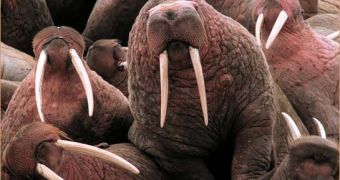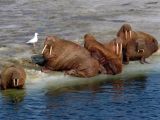1.Ten million years ago, walruses were the most diverse seals of the Pacific Ocean; some ate fish, other mollusks and bottom invertebrates. Five million years ago, walruses of California ate clams and sucked their content, missing lateral teeth for this purpose; this is an extinct branch.
Modern walruses evolved from another group. Five-eight million years ago, walruses passed into the Northern Atlantic through the sea passage that split North America from South America. The Pacific walruses disappeared, whereas these ones flourished and, 1 million years ago, invaded the Arctic Ocean. 300,000 years ago, they entered from the Arctic back into the Northern Pacific.
2.Adult male walruses form large concentrations on the beaches; this happens from May to October, when there is no wind and the temperature is over 15o C. Old or ill walruses live more retreated. If space is limited, individuals can stay ones over the others.
Inside the colony, the younger males stay at the periphery and the older adult males in the center. If the alarm call is given, all walruses will take refuge into the water. In the sea, the dominant males swim in the front.
The other walruses come to aid a walrus attacked by a polar bear.
During the summer, the other walruses migrate northward, following the ice pack, in groups of females with young, adolescent (around 4 years old) and young adult males (around 9 years old). The migrations may mean 3,000 km (1.870 mi) annually. During the winter, when Arctic ice pack extends and turns too thick, they return to the south.
Older males do not make long migrations and, this way, they do not compete for food with the young males and females.
Males (in rare cases females as well) have pharyngial sacks that act like resonating chambers for the sounds emitted frequently during the mating and at diving. Because of these sacks, walruses can float in the water in vertical position, with the head above the water.
Walruses avoid mainland shores, where they can e attacked by land predators like wolves and bears. Beaching is also necessary for wound healing, as wounds heal very slowly if staying continuously in sea saltwater.
3.Longer tusks mean higher hierarchical position and older age. If a male loses a tusk, he will lose his rank in the hierarchical scale.
The tusks are 0.5 m (1.6 ft) long in females, and 1 m (3.3 ft) long and 3-6 kg (6-13 pounds) heavy in males. In females, they have a round section, whereas in males they are elliptical, and they can help to determine the age of the animal. In Anchorage (Alaska), carved tusks can cost $ 2,000.
They pierce the gum, by the age of 6 months, and are 2.5 cm (1 in) at 1 year old. They are visible by the age of 18 months, and grow continuously all the walrus' life. The skull is 42 cm (1.4 ft) long and 24 cm (0.8 ft) wide. Walruses have an overall of 18 teeth, lacking molars and having only upper incisor teeth.
During the competition for females, males show off their tusks. If the tusks are similar, they will fight and the weaker one will cede. Old males have the body covered by scars. The tusks are also used against predators and for making breathing holes in the ice. Walruses also use the tusks for dragging themselves out of the water on the shore. The walrus with the largest tusks is the alpha individual of the group. Walruses do not dig with the tusks, which have no feeding role.
Mating occurs in January-February. The 12-year-old males occupy a nuptial territory on ice pack, copulating all the females (which are sexually mature by the age of 4-5), following fights. Females form now groups of about 15 or larger. Males are sexually mature by the age of 7-9. Each group of females is followed by a few males, who remain in the water nearby. Males try to lure females, putting out repeated underwater calls, named clicks and bell rings, interpolated with roars and hisses at the surface. They are helped by the pharyngial sacks in producing these sounds.
Males cannot force females to copulate, as females have many alternative escape points out of the ice pack, and are lighter and more agile in the water. In the end females choose from amongst the fighting males, and mating takes place in the water.
Births take place in May, after a 15-16-month gestation. The egg is delayed 4 months till implanting on the uterine wall. That's due to the fact that the females must give birth on the ground during the next spring. During the spring, sea is warmer, and the infant has a higher chance of survival. The newborn is about 1.2 m (4 ft) long and 60-65 kg (133-144 pounds). For 6 months it is milk fed and triples its weight. The milk teeth are lost in the womb, and the offspring are born toothless. After 6 months, the young start imitating the adults digging for mollusks, but it will remain with the mother for protection till another walrus pup is born, for 2-4 years. After that, young males leave their mothers, to join the male groups. The offspring and the young are darker skinned. Walruses can live up to 40 years.
4.Walruses can dive to 200 m (660 ft) and keep their breath for 30 minutes. Generally, they do it for 10 minutes. The nostrils have 5 cm (2 in) in diameter.
In water, walruses can reach 35 km (22 mi) per hour, but they swim with a medium speed of 7 km (4 mi) per hour. Walruses do not go further than 30 km (19 mi) off the coast. Propelling is ensured by rear limbs, while the front limbs work like rudders.
The snout has about 450 vibrisae (whiskers), conferring them a developed touch sense for detecting mollusks. The vibrisae can be 15 cm (6 in) long, 3 mm wide, and can reveal the mood of the animal. The vibrisae are also used for communication, and two walruses can be seen "kissing" each other. Some walruses are blue-eyed.
The skin is 4 cm (1.6 in) thick and, in very cold water, it is almost white (due to vasoconstriction, for restricting heat loss). When taking sunbaths, the skin of the walruses turns pink-brown, due to the blood flow. The shoulder skin in males presents 5 cm (2 in) nodules for protection. There is a fatty layer under their skin 15 cm (6 in), as protection against the cold.
Walruses eat clams (smaller than 15 cm (6 in)) and mussels, about 20 tons per individual annually. The stomach can store 5 liters of clams. Other consumed animals are: shrimps, crabs, snails, cefalopods (squids, cuttlefish, octopuses), annelid worms, sea cucumbers and sea squirts (Tunicata). Occasionally, they eat small fish (like herrings), sea birds, and young seals; also, stranded cadavers of sea mammals (like belugas, or narwhals).
In the murky waters where walruses feed, sight is of no use, and they rely on touch when looking for food, employing their vibrisae. They grub like pigs, using the hardened upper edge of the muzzle to dig up shelled mollusks. Any prey, no matter how deep it is buried in its den, is dug up using water jets.
Walruses feed in cycles of 9 days: 2 days of resting on the beach and 7 days of feeding in the sea.
5.There are about 250,000 walruses, split in two races.
The north Pacific walruses (Odobenus rosmarus divergens), about 20,000 individuals, inhabit the shores of Bering Sea, northern Siberia (from Chukchi Sea to Laptev Sea). There is even a population of 4,000 individuals in the Laptev Sea (north-central Siberia). One colony is found in Alaska (Ronde Island), seven in Russia. These walruses can be 4.2 m (14 ft) long and weigh 2 tons, and the tusks make 17 % of the body length.
The north Atlantic walrus (Odobernus rosmarus rosmarus) lives in Novaia Zemlia, Svalbard, Northern Atlantic, eastern Hudson Bay, eastern Arctic Archipelago of Canada, eastern/western Greenland, northern Labrador. They can be 3.5 m (11.6 ft) long, and tusks make 12 % of the body length.
The North Atlantic race is smaller than the Pacific race. For example, in the Bering Sea (Northern Pacific) females are 2.7 m (9 ft) long and 830 kg (1,844 pounds) heavy, while the males are 3.5 m (11.6 ft) long and 1,210 kg (2.690 pounds) heavy. In Hudson Bay, female walruses are 2.5 m (8.3 ft) long and 565 kg (1.255 pounds) heavy, while the males are 2.9 m (9.6 ft) long and 795 kg (1.767 pounds). The largest walruses can weigh 2 tons.
The only natural predators of the walruses are the polar bear, large sharks and the orca.
6.Most mammals have an unique bone, named baculum (penis bone, penile bone or os penis), inside their penis. The sole mammals lacking the baculum are humans, horses, donkeys, rhinoceros, marsupials, rabbits, cetaceans (whales and dolphins), elephants and hyenas.
The baculum's size and shape varies, depending on the species and the largest baculum can be as long as 30 inches (75 cm): the size of a human femur!
But, a species of walrus that extinguished 12,000 years ago had a 4 ft (1.2 m) long baculum, with a dramatic curve to its tip and was covered with weathered skin and dry muscle tissue. In modern walruses, the baculum is straight, not curbed.

 14 DAY TRIAL //
14 DAY TRIAL // 
